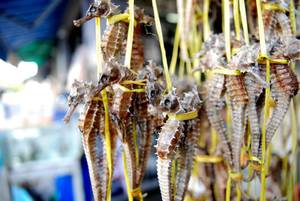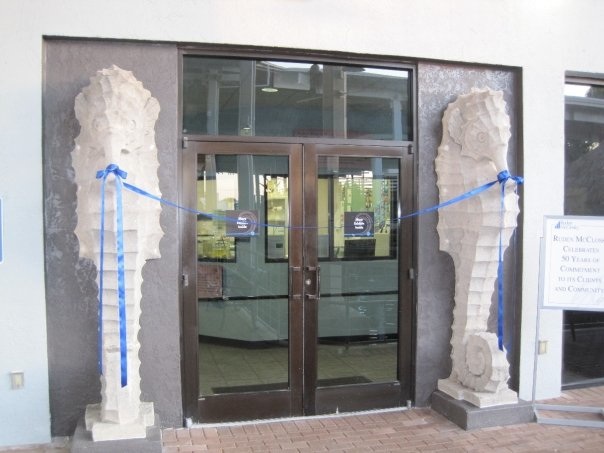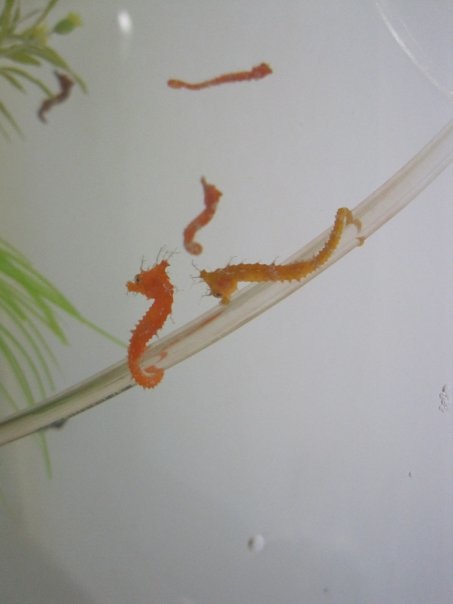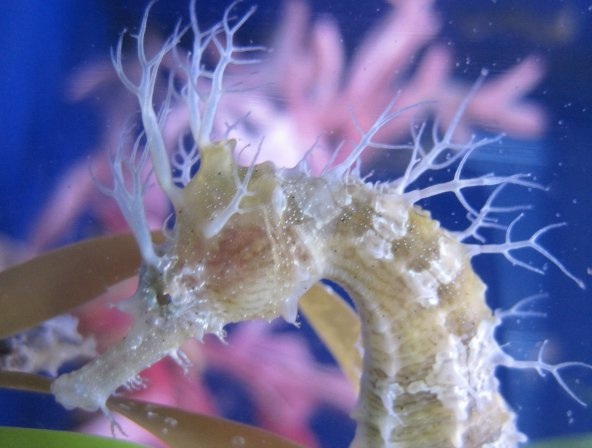Supplying the seahorse trade
Interview with
Helen - Every year millions of dead seahorses are traded as Traditional Chinese Medicines. They're thought to be a remedy for all sorts of conditions from broken bones and asthma, to kidney complaints and even a flagging libido, and conservationists are worried this is putting too much pressure on some wild populations.
 There is also a roaring trade in live seahorses for public aquariums and for people who want to keep them at home as pets.
There is also a roaring trade in live seahorses for public aquariums and for people who want to keep them at home as pets.
So, I paid a visit to Mote Marine Laboratory in Sarasota in Florida, to find out how breeding seahorses in captivity is offering a way of cutting down on the number of seahorses we take from the wild every year.
Here's supervisor of Mote's Seahorse Conservation Lab, Shawn Garner.
Shawn - This is a laboratory that's on exhibit to a public aquarium 300...
Helen - In fact we can see people walking right by now, peering in the window...
Shawn - And waving, yes. So education is key. We want to show children and adults  seahorses because it is the coolest animal in the world.
seahorses because it is the coolest animal in the world.
Helen - I'm glad you agree with me on that.
Shawn - There's no other animal that has a head like a horse, eyes like a chameleon, pouch like a kangaroo, tail like a monkey. And it's a fish that has the only true male birth. That is the coolest.
But the really main thing about this laboratory is breeding seahorses, learning how to do it, and sharing that information with other facilities so that they can breed seahorses.
We're breeding them for other zoos and aquariums around the country do they don't have to collect from the wild.
Helen - That's great, so how long will you keep seahorses here before you send them off to other aquariums?
Shawn - We wait for about 6 months, 8 months is ideal when we ship. And we ship all around the country and hopefully around the world sooner or later.
Helen - How do you send a seahorse? You send them by plane I take it?
Shawn - Yeah, actually we use Fedex. We put it in a bag of water, one third really clean water, two thirds pure oxygen. I put 3-4 seahorses in a bag and I give them a toy. Because anyone who has driven around with kids in the back, they hit each other, they mess with each other, and I don't want that stress. So I give each seahorse a toy to hitch onto and that's kind of like their protection.
And then they're triple-bagged, put in a Styrofoam shipping container, then there's a heat pack or cool pack, and we ship them overnight. We've shipped a thousand or more seahorses and maybe had one problem but it's been really good, and the horses arrive there perfect.
What we're looking at is the brood stock. And the brood stock means that they're animals just for breeding. They're here, they're my best seahorses right now.
Helen - They're the studs?
Shawn - They're the studs, and the queens, I guess. They have good genetics. They're usually wild caught. Now I'm legally allowed to take a few wild caught seahorses from the environment. So really all they're here doing is breeding and eating. And it happens in the morning. They go up in the water column, they either do their mating dance or they transfer eggs, and then they kind of leave each other alone the rest of the day.
Helen - And, how often will they actually have babies?
Shawn - The male will get pregnant, of course. His gestation is about 25 days. He will release the babies and pretty much the next day or two days after, he's pregnant again. And this happens pretty much his entire life from 6 months all on up to about 4 years, and he is pregnant most of his life.
Now, he gets pregnant so much he can actually fake being pregnant.
Helen - This is news to me!
Shawn - Yeah, he can actually inflate his pouch with water and tell his girlfriend or his wife 'I'm pregnant already, I can't accept your eggs this month'. And she will actually dump her eggs on the ground, which is terrible because it takes 40% more energy to create the eggs than to gestate them.
Helen - Wow, that's crazy. Okay, so we have, these are the mums and dads basically. And then the babies come, and then these are the guys over here? These are some of the newborns in this tank? Well, you haven't got any tiny ones, but these ones here?
 Shawn - Yeah, we didn't have seahorse babies last week, but we had some two weeks ago and we're looking at them right now. It's a brood of probably 100. We're looking at Hippocampus erectus, the lined seahorse.
Shawn - Yeah, we didn't have seahorse babies last week, but we had some two weeks ago and we're looking at them right now. It's a brood of probably 100. We're looking at Hippocampus erectus, the lined seahorse.
So what they're doing is they're circulating around the tank. They're in a specially designed tank called a Kreisel or Gyro, and it's a tank designed for animals that are planktonic, that are floating in the ocean, we like to tell the kids planktonic means 'Go with the flow'. So they're circulating and they're eating the smallest food that we have, and we actually grow plankton here. And they're eating it and they're swimming and that's all they're doing right now.
Helen - And in this tank here there are some equally as tiny animals, but they're a bit older, aren't they?
Shawn - Yeah, these are Hippocampus zostera, the pygmy seahorse. And, very small animal, one inch is pretty much max. They only have 10-12 babies at a time, but they have one of the largest babies of any other seahorse, and they're pretty smart. There are so smart that when we try and take them out of their parent tank they can run away from the net. They know a net is danger. They're very smart animals, I love these guys, they're so cute.
Helen - They are amazingly cute. They're so tiny I can hardly see them. Awesome.
Seahorses are pretty sensitive aren't they, to their conditions in which they're living. The water has to be the right salinity, temperature and so on, and they are kind of susceptible to getting diseases too, that's the case, right?
Shawn - Like any animal they can get stressed out. Just like humans, you get stressed out, and when you get stressed out you're more prone to getting a cold or the flu or what have you. Yeah, seahorses are very prone to diseases and bacteria. So we try to provide the most calm environment for them.
We found out lately that sounds are huge in the seahorse world, that load sounds, motor sounds and vibrations from the world causes seahorses to become stressed out which I turn gets them not to reproduce as much, not live as long.
When we built this lab we specially chose the pumps, the lighting, all the filtration so that everything is vibration-free, there's not a lot of metallic sounds in the water. And it's really, hopefully, proven to be a great thing. A lot of zoos and aquariums have big tanks that have really strong pumps and concrete and vibrations, they have a lot of problems keeping seahorses alive. Well, we keep them alive and we breed them in their thousands. So, I think the vibrations and the sounds are really important to seahorses' survival.
everything is vibration-free, there's not a lot of metallic sounds in the water. And it's really, hopefully, proven to be a great thing. A lot of zoos and aquariums have big tanks that have really strong pumps and concrete and vibrations, they have a lot of problems keeping seahorses alive. Well, we keep them alive and we breed them in their thousands. So, I think the vibrations and the sounds are really important to seahorses' survival.
Helen - You've been operating on seahorses?
Shawn - Not me, but we have a vet that actually did one of the first laser surgeries on a seahorse. We had one seahorse a year or two ago that grew a tumour on its tail.
What we did is, we grabbed the animal, and we actually put it under, under anesthesia.
Helen - Oh my gosh, how did you do that?
Shawn - We took it out of the water, and put it on a tray and ran a tube into its mouth that pumped anesthetic water and it went right past his gills and put him under. He was dry but he was still breathing and he was knocked unconscious.
And so the vet got the laser out, turned the setting to the lowest setting because he was so worried how frail a seahorse is. And tried to take the tumour off - didn't work. So he raised the level up a little bit more - no go. He had to raise the level up so high it was the same as turtle shells, and then he was able to take the tumour off. And so we took that seahorse and put him back in his regular water, he woke up, and he survived another year or two after that. It was amazing, it was so neat.
Helen - That is very cool. Seahorse hospital, here we are.
Shawn - Yeah, we'll do anything to keep them alive. It's important.
Find out more
Mote Marine Laboratory
Hippocampus zostera on Fishbase
Hippocampus erectus on Fishbase










Comments
Add a comment